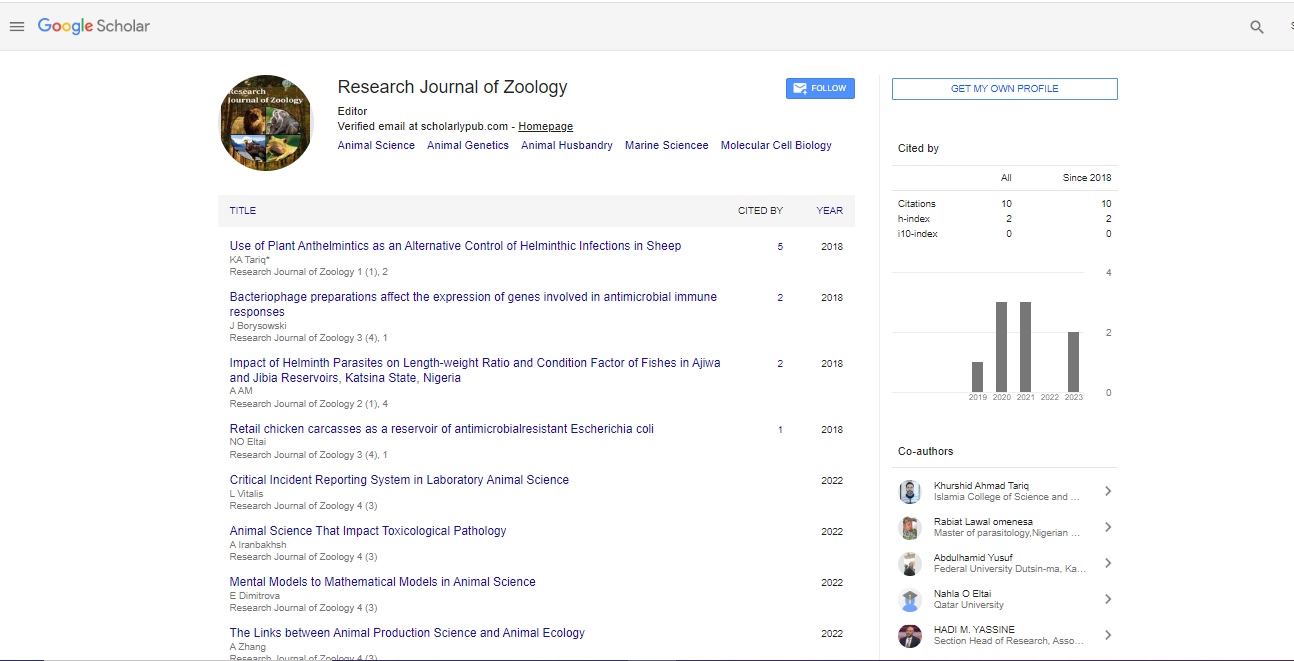Perspective, Res J Zool Vol: 5 Issue: 2
The Role of Cytogenetics in Health and Research
Ishamol Diddens*
1Department of Zoology, Harvard University, Cambridge, Massachusetts, USA
*Corresponding Author: Ishamol Diddens,
Department of Zoology, Harvard
University, Cambridge, Massachusetts, USA
E-mail: diddensishamol@gmail.com
Received date: 29 May, 2023, Manuscript No. RJZ-23-106921;
Editor assigned date: 31 May, 2023, PreQC No. RJZ-23-106921 (PQ);
Reviewed date: 14 June, 2023, QC No. RJZ-23-106921;
Revised date: 21 June, 2023, Manuscript No. RJZ-23-106921 (R);
Published date: 28 June, 2023, DOI: 10.4172/Rjz.1000082.
Citation: Diddens I (2023) The Role of Cytogenetics in Health and Research. Res J Zool 5:2.
Description
Chromosomes are the thread-like structures found within the nucleus of eukaryotic cells, containing the genetic material in the form of DNA. They exist in pairs, with one set inherited from each parent, except for the sex chromosomes (X and Y) which determine an individual's sex. By analyzing the number, structure, and behavior of chromosomes, cytogeneticists can gain valuable insights into various genetic conditions. The history of cytogenetics can be traced back to the late 19th and early 20th centuries when researchers first observed chromosomes under a microscope. In 1882, German biologist Walther Flemming coined the term "chromatin" to describe the thread-like structures he observed during cell division. Then, in 1902, Theodor Boveri and Walter Sutton independently proposed the chromosome theory of inheritance, suggesting that genes are located on chromosomes and are the units of heredity.
Techniques in cytogenetics
Over the years, various techniques have been developed to study chromosomes and cytogenetic abnormalities. The most common techniques include karyotyping, Fluorescent In Situ Hybridization (FISH), Comparative Genomic Hybridization (CGH), and Chromosomal Microarray Analysis (CMA).
Karyotyping: Karyotyping is a basic cytogenetic technique used to visualize and analyze the number, size, and shape of chromosomes in a cell. It involves arresting cells during mitosis (cell division), staining the chromosomes, and arranging them in pairs to form a karyogram or karyotype. Karyotyping is instrumental in diagnosing numerical chromosomal abnormalities, such as trisomy 21 (Down syndrome) and Turner syndrome.
Fluorescent In Situ Hybridization (FISH): FISH is a molecular cytogenetic technique that uses fluorescently-labeled DNA or RNA probes to target specific chromosomal regions. This technique is used to identify structural chromosomal abnormalities, such as translocations, deletions, and duplications. FISH is widely employed in cancer diagnostics and prenatal testing for conditions like cri-du-chat syndrome.
Comparative Genomic Hybridization (CGH): CGH is a method used to detect chromosomal imbalances, such as gains and losses of genetic material, throughout the entire genome. It involves hybridizing fluorescently-labeled patient DNA with normal reference DNA and then analyzing the fluorescence intensity ratios along the chromosomes.
CGH has proven to be valuable in identifying genetic changes in various cancers and developmental disorders.
Chromosomal Microarray Analysis (CMA): CMA is an advanced technique that allows for high-resolution detection of chromosomal imbalances. It uses microarray technology to analyze thousands of DNA sequences simultaneously, providing a comprehensive view of the genome. CMA has become a primary diagnostic tool in the evaluation of individuals with developmental delays, intellectual disabilities, and autism spectrum disorders.
Applications in medicine
Prenatal diagnosis: Cytogenetic testing on fetal cells obtained through amniocentesis or chorionic villus sampling helps identify chromosomal abnormalities and genetic disorders prenatally. This information enables parents and healthcare providers to make informed decisions about the pregnancy and potential interventions.
Cancer diagnostics: In oncology, cytogenetic analysis of cancer cells helps classify tumors, predict disease prognosis, and determine appropriate treatment strategies. Specific chromosomal aberrations are associated with different types of cancer, aiding in targeted therapies and personalized medicine.
Genetic counseling: Cytogenetic findings are important in genetic counseling sessions. Genetic counselors use this information to assess the risk of recurrence in families affected by genetic disorders and provide guidance on family planning and reproductive options.
Identification of microbial agents
In microbiology, cytogenetic techniques can be used to identify and characterize microorganisms, particularly in infectious disease diagnosis and research.
Forensic applications: Cytogenetic methods can also be applied in forensic science for human identification and solving criminal cases, especially in instances where DNA sequencing might not be feasible. Despite its significance, cytogenetics does have some limitations. The traditional karyotyping technique may not detect small-scale chromosomal aberrations, such as submicroscopic deletions or duplications. This led to the development of higher resolution methods like FISH, CGH, and CMA.
Conclusion
The future of cytogenetics lies in the integration of advanced molecular techniques, such as Next-Generation Sequencing (NGS), which allows for a more comprehensive analysis of the genome. NGSbased methods can identify point mutations, single-nucleotide polymorphisms, and other genetic variations, making them particularly valuable in uncovering the genetic basis of complex disorders.
Cytogenetics is a difficult field of genetics that has significantly contributed to our understanding of human genetics, disease mechanisms, and the development of targeted therapies. Its applications in medicine and various other disciplines continue to evolve, paving the way for advancements in precision medicine and personalized healthcare. As technology and research progress, cytogenetics will undoubtedly play an increasingly vital role in improving human health and well-being.
 Spanish
Spanish  Chinese
Chinese  Russian
Russian  German
German  French
French  Japanese
Japanese  Portuguese
Portuguese  Hindi
Hindi 
